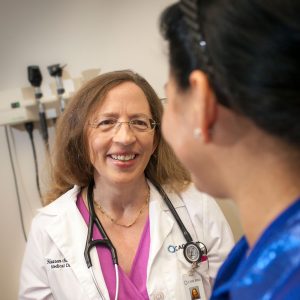 Major health care systems are re-designing their care delivery and care management systems with an eye toward finding ways to keep large groups of individuals healthy. But what are the best ways to provide care and establish long-term positive outcomes for individuals with very limited resources?
Major health care systems are re-designing their care delivery and care management systems with an eye toward finding ways to keep large groups of individuals healthy. But what are the best ways to provide care and establish long-term positive outcomes for individuals with very limited resources?
This “population health” approach to care is taking the entire U.S. health care industry by storm. But when it comes to serving populations with the greatest health care needs and the most barriers to maintaining good health, what are the key drivers of success? As we switch from volume to value-based models of care, how will this transition impact the outcomes for individuals with very few if any resources?
For more than 60 years my health care agency, Care Ring, has been working to fulfill a vision for a community in Charlotte that promotes, protects, and improves the health and well-being of all people.
Today, half of our patients come to us with multiple chronic diseases. The vast majority live well below 100% of the Federal Poverty Level. Few of our thousands of patients are eligible for public insurance like Medicaid, nor do they receive health insurance coverage through their employer. This is a population of very low-income and often-times very unhealthy individuals who have very limited options for care.
And yet, the outcomes we achieve are on par with, or better than, what many private sector providers achieve for their patients.
Consider just a few key outcome measures:
-- For every 1000 patients in our Physicians Reach Out program (which we operate on behalf of nearly 1600 voluntary physicians) our Emergency Department visits are less than 30 per month and hospitalizations are less than 4 per month, both far lower than what we see for similar populations across the country. Just last year the physicians and providers in our PRO network donated more than $17 million in services to care for individuals in need, improving outcomes long before patients arrive for treatment at a local emergency department.
-- 100% of the children in our Nurse-Family Partnership program are current with their immunizations at 2 years old, and 86% of the mothers in our program had no subsequent pregnancy at 24 months post-partum, both statistics outpacing national trends for this population.
Four key principles should serve as a guide in developing programs and interventions to address and improve health outcomes for populations with very limited resources:
1) Recognize the pervasive impact of poverty
2) Understand that long-term wellness occurs beyond the walls of the clinic
3) Keep your eyes on the prize (healthy patient outcomes), but perhaps most importantly:
4) Recruit for passion
 1) Recognize the pervasive impact of poverty.
1) Recognize the pervasive impact of poverty.
Those living in poverty experience a much higher rate of a wide array of health problems. The statistics are grim but important to keep in mind when taking into account the challenges people in poverty face in establishing and maintaining good health, such as:
-- People living in poverty have much higher rates of smoking.
-- Children growing up in poverty often have less robust brain development.
--The corrosive impact of adverse childhood experiences negatively affects quality of life and efforts to achieve wellness in adulthood.
-- Families living in poverty experience much greater issues of food insecurity.
The health challenges that a person in poverty faces can often be much more difficult for providers to address and mitigate. Most of our patients present to us with multiple chronic conditions, often because they have delayed treatment due to a lack of accessible or affordable care.
Poverty can have a stranglehold on an individual’s ability to thrive. From lack of affordable housing to limited transportation options and much more, an individual living in poverty often arrives at a community clinic – or at an emergency department doorstep – with an array of challenges in addition to the immediate need for clinical care.
2) Long-term wellness occurs far beyond the walls of the clinic.
 The “social determinants of health” address human and social issues outside the scope of care for most clinical providers. We recognize that long-term healing occurs far beyond our clinic walls, and have established formal partnerships with a host of community partners who address these broader social determinants of health that often bedevil people living in poverty.
The “social determinants of health” address human and social issues outside the scope of care for most clinical providers. We recognize that long-term healing occurs far beyond our clinic walls, and have established formal partnerships with a host of community partners who address these broader social determinants of health that often bedevil people living in poverty.
As a few examples, some of our families receive child care subsidies from Smart Start of Mecklenburg, others receive utility and rent assistance and access to furniture from Crisis Assistance Ministry. Some families are benefiting from subsidized housing at Renaissance West, a purpose-built community in Charlotte.
The key is that high quality clinical interventions only go so far for individuals in poverty. Without building long-term partnerships with providers and agencies that can address the broader “social determinants of health,” then our clinical intervention can only address one slice of a much larger challenge.
Social workers, health coaches, and case managers are the glue connecting our patients to essential resources in the community. These critical team players are experts in finding the local support necessary to address the social determinants of health that often make achieving long-term health and wellness very difficult for our neighbors living in poverty.
The emerging ONE Charlotte Health Alliance, a consortia of leading major health care systems (Novant Health and Atrium Health), along with the Mecklenburg County Health Department, is a promising step forward in linking health care providers with social and human resources across the region.
ONE Charlotte is taking an intentional step to bind together clinical providers to address very real health care needs in some of our most fragile neighborhoods. They also recognize that for long-term success, health care agencies and health care systems must go beyond simply providing better access to health care. Individuals living in poverty not only need better health care access; they also need a wide array of human and social supports – adequate and affordable housing and quality food, transportation, and much more.
3) Keep your eyes on the prize - healthy patient outcomes.
 Our primary mission is to empower individuals with limited resources to establish and maintain good health. At the end of the day our donors and community leaders evaluate our performance on our success in reaching this mission.
Our primary mission is to empower individuals with limited resources to establish and maintain good health. At the end of the day our donors and community leaders evaluate our performance on our success in reaching this mission.
-- We know, for example, that 72% of our Nurse-Family Partnership clients who initially enrolled in our program without a high school diploma or GED will achieve these goals or remain in school at their child’s 2nd birthday. Our moms who are visited in their homes by our nurses have a 28% reduction in maternal smoking and witness a 72% drop in the experience of violence reported during pregnancy.
-- We prevent more than 800 unnecessary emergency department visits in our Physicians Reach Out program each year, and we estimate that more than 300 individuals avoid unnecessary hospitalization each year.
-- Three out of every four of our hypertension patients in our low-cost clinic get their blood pressure under control and more than 75% of our diabetic patients have their diabetes under control, which outpaces the performance for many other clinics serving patients with extensive needs.
Serving as an affordable, accessible health care access point for those with very limited resources serves a humanitarian purpose and fills a need in our community. These kinds of positive health outcomes are essential for us to assess and evaluate if we are adequately addressing immediate health care needs for our neighbors in great need. Perhaps more importantly these outcomes give us confidence we are moving people toward a path of long-term health and wellness.
4) Recruit for passion.
 The first three principles – recognize the impact of poverty, look for solutions beyond the walls of a traditional health care clinic, and relentlessly focus on healthy outcomes – are necessary but not sufficient elements to establishing a successful health care practice serving individuals with very limited resources.
The first three principles – recognize the impact of poverty, look for solutions beyond the walls of a traditional health care clinic, and relentlessly focus on healthy outcomes – are necessary but not sufficient elements to establishing a successful health care practice serving individuals with very limited resources.
The final element is based in human capital, and relates to the more intangible quality of being passionate about giving back and possessing a deep concern for those among us with the least. Our staff dedicates their time, talents, and commitment to showing kindness and dignity and respect to our neighbors in need every day.
I’ve written before on the power of showing our love and compassion for those on the margins. I believe this is the most essential element in our success.
For a health care agency of any kind serving the poor – a private practice taking Medicaid-eligible patients, a managed care organization serving a diverse population of individuals, an agency run by a county or other unit of government or even a faith-based clinic operating on limited hours and with limited services – I believe the most crucial element for success is the ability to attract and retain individuals with a deep compassion for folks in need.
You need people on staff, on the board of directors, and out in the community who embrace the agency’s mission and who care deeply about those who are hurting and have very few places to turn for help. You need people who want to be part of a larger effort to assist individuals needing a loving hand to help them on their path toward life-long wellness.
Care Ring has been in the “population health” business for more than six decades, with a particular mission to help people with very limited resources. As health care systems, payers, and providers think about how best to serve very low income populations, recognizing the impact of poverty, partnering with human and social agencies beyond the clinic walls, focusing relentlessly on achieving healthy patient outcomes, and most importantly recruiting for passion will be essential elements of any successful effort.
